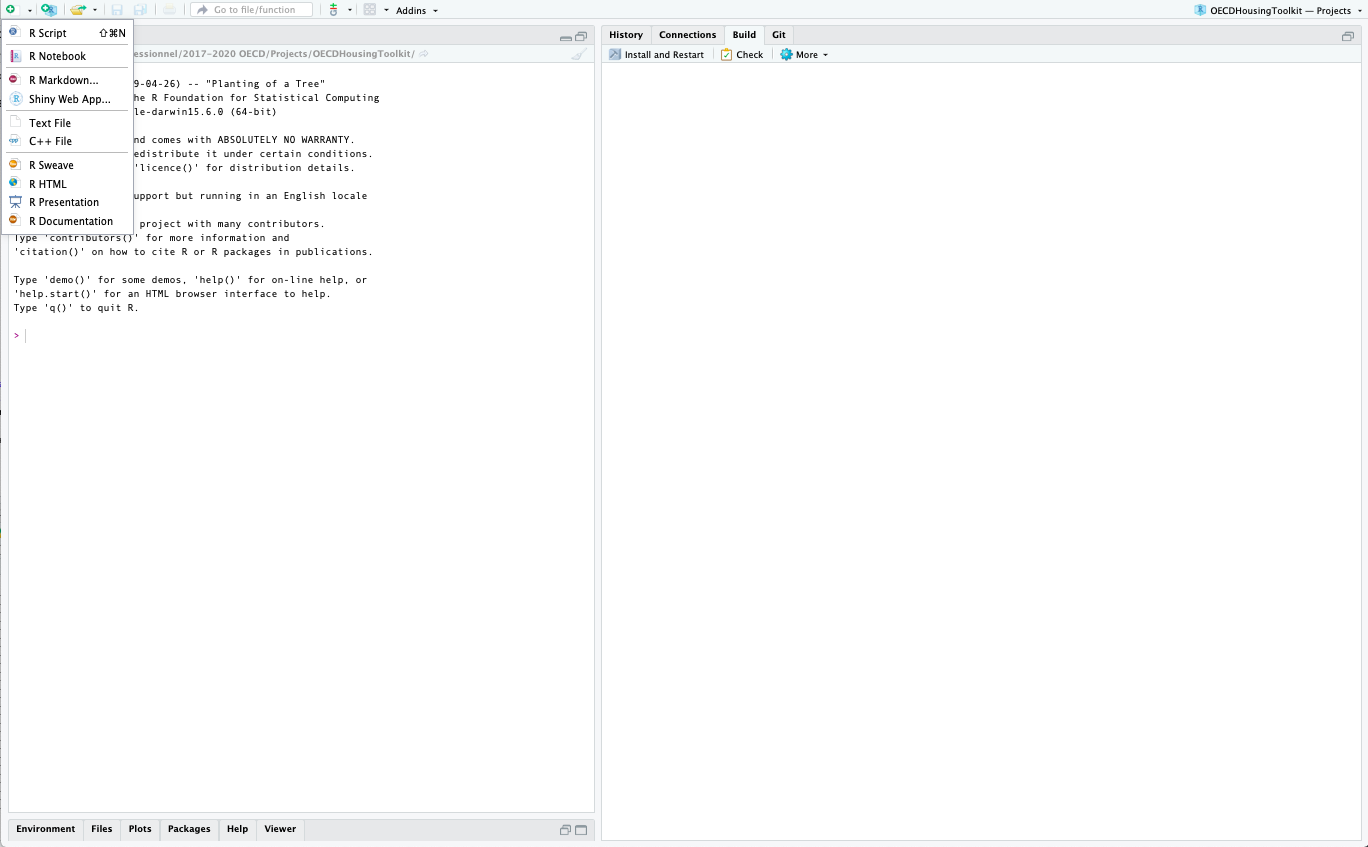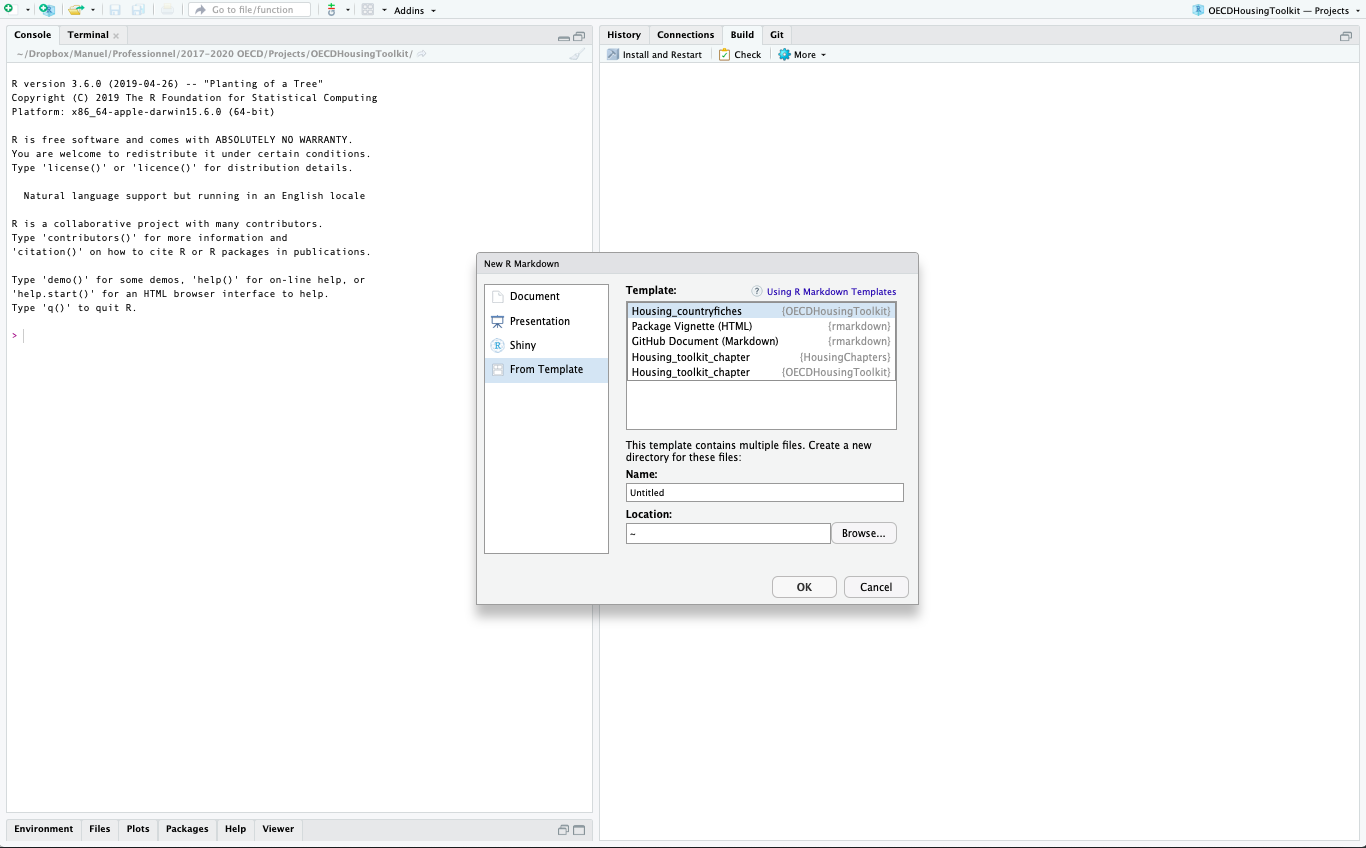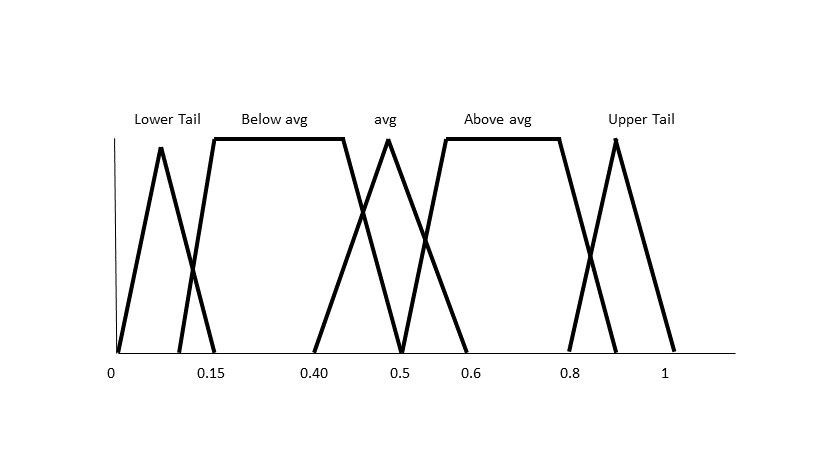README.md
In manuelbetin/OECDHousingToolkit: Provide Rmarkdown template to generate chapters of the OECD housing toolkit and OECD Housing horizontal project country fiches
Housing Toolkit
Description
Provide template for the creation of web chapters (html) and country fiches (pdf) with OECD style
Authors
- Manuel Betin
- Maxime Nguyen
- Federica Depace
Version
0.2.1
Install package
#install and load packages
install.package("devtools")
library(devtools)
#install toolkit package
devtools::install_github("manuelbetin/OECDHousingToolkit")
#load toolkit
library(OECDHousingToolkit)
Open Rmardown templates
Open a new R studio section and load the package
library(OECDHousingToolkit)
Then click on create new file and click on Rmarkdown

Click from template and select the template to use as well as the name of the folder and the location where to create the new template

Once you selected housing_countryfiches it will create a folder containing the template.
In this folder you will find the template "thenameyougave.Rmd" and the necessary files for compilation. To generate the country fiche:
Country fiches generator
In order to generate the country fiches please follow the instructions
open new r script and save it in the folder of the template: country_fiche_generator.r
library(OECDHousingToolkit)
setwd(pathofthenewlycreatedfolder)
Select the iso3 code of the countries of which you want to create the country fiche and
change the name of the .Rmd file to the name of the .Rmd file in the folder of the template
ctries=c("USA","FRA")
htk_generate_ctry_fiches(Rmdfile="nameofRmdfile.Rmd", #name of the template of the country fiches
country_code_list=ctries, #list of countries of interest
path="Country_fiches") #name of the folder where to store the pdf files created
run the code
Documentation on Linguistic Description of Complex Phenomena
Literature on computational theory of perception
The NL system is stratefed in 4 strata:
- Context: the meaning of NL depends on the domain of experience
- Semantic: the meaning ressources stored in the NL system that are acquiredd through experience in terms of meaning feature
- Lexico-grammar: the grammatical ressources in the NL system to realize the meaning at the semantical stratum as a a text
- Expression: ressources to realize the final expression of text
Text generation = Context => Expression
Text understanding= Expression => Context
Granular linguistic model of a phenomenon as structured meaning. The structuration is a three step process:
- A selection of a set of situation types
- In each situation type select a set of figures
- For each figure select a set of clauses
Computational perception (CP)
The computational model of a unit of meaning about the phenomenon to be modeled
CP is a couple (A,W) with A={a1,...,aN} a set of linguistic expressions that represents the whole linguistic domain of the CP
W={w1,...wN} set of vqlidity degree, the context of validity depends on the thruthfulness and perceverance of each sentence
in the context of use.
Perception mapping (PM) are used to create new CP
PM is a tupple (U,y,g,T)
U =(u1,...,uN) the input data
y = output CP y=(Ay,Wy)={(a1,w1),...,(an,Wn)}
g = aggregation function Wy=g(wu1,...,Wun) with w1,...,Wn a vector of degree validity
T = Text generqation algorithm that generates the linguistic expression in Ay. T has associated a figure and uses the input DATA to
choose the most suitable clauses to describe the current state of the monitored phenomenon.
GLMP consiste of a network of PMs
each PM receives a set of input CPs adn transmits upwards a CP. Each output CP is explained by the PM using a set of input CPs. In the
network, each CP covers specific aspects of the phenomenon with certqin degree of granularity
1PM: first order perception mapping => those which are input to the GLMP.
PMs which input are CPs are called 2PM and their outputs are 2CP.
The algorithm and technical background
Gracian Trivino*, Michio Sugeno, 2012, Towards linguistic descriptions of phenomena,
European Centre for Soft Computing, Mieres, Asturias, Spain
papers LDCP
P. Conde-Clemente, Jose M. Alonso, G. Trivino. "rLDCP: R package for text generation form data".
In Proceedings of the IEEE International Conference on Fuzzy Systems (FUZZ-IEEE), Naples, Italy, 2017 (DOI:10.1109/FUZZ-IEEE.2017.8015487).
https://www.aclweb.org/anthology/W17-3538.pdf
documentation of the R package
Country fiche text generation example

manuelbetin/OECDHousingToolkit documentation built on July 5, 2023, 12:02 p.m.
Housing Toolkit
Description
Provide template for the creation of web chapters (html) and country fiches (pdf) with OECD style
Authors
- Manuel Betin
- Maxime Nguyen
- Federica Depace
Version
0.2.1
Install package
#install and load packages
install.package("devtools")
library(devtools)
#install toolkit package
devtools::install_github("manuelbetin/OECDHousingToolkit")
#load toolkit
library(OECDHousingToolkit)
Open Rmardown templates
Open a new R studio section and load the package
library(OECDHousingToolkit)
Then click on create new file and click on Rmarkdown

Click from template and select the template to use as well as the name of the folder and the location where to create the new template

Once you selected housing_countryfiches it will create a folder containing the template.
In this folder you will find the template "thenameyougave.Rmd" and the necessary files for compilation. To generate the country fiche:
Country fiches generator
In order to generate the country fiches please follow the instructions
open new r script and save it in the folder of the template: country_fiche_generator.r
library(OECDHousingToolkit)
setwd(pathofthenewlycreatedfolder)
Select the iso3 code of the countries of which you want to create the country fiche and change the name of the .Rmd file to the name of the .Rmd file in the folder of the template
ctries=c("USA","FRA")
htk_generate_ctry_fiches(Rmdfile="nameofRmdfile.Rmd", #name of the template of the country fiches
country_code_list=ctries, #list of countries of interest
path="Country_fiches") #name of the folder where to store the pdf files created
run the code
Documentation on Linguistic Description of Complex Phenomena
Literature on computational theory of perception The NL system is stratefed in 4 strata: - Context: the meaning of NL depends on the domain of experience - Semantic: the meaning ressources stored in the NL system that are acquiredd through experience in terms of meaning feature - Lexico-grammar: the grammatical ressources in the NL system to realize the meaning at the semantical stratum as a a text - Expression: ressources to realize the final expression of text
Text generation = Context => Expression Text understanding= Expression => Context
Granular linguistic model of a phenomenon as structured meaning. The structuration is a three step process: - A selection of a set of situation types - In each situation type select a set of figures - For each figure select a set of clauses
Computational perception (CP) The computational model of a unit of meaning about the phenomenon to be modeled CP is a couple (A,W) with A={a1,...,aN} a set of linguistic expressions that represents the whole linguistic domain of the CP W={w1,...wN} set of vqlidity degree, the context of validity depends on the thruthfulness and perceverance of each sentence in the context of use.
Perception mapping (PM) are used to create new CP PM is a tupple (U,y,g,T) U =(u1,...,uN) the input data y = output CP y=(Ay,Wy)={(a1,w1),...,(an,Wn)} g = aggregation function Wy=g(wu1,...,Wun) with w1,...,Wn a vector of degree validity T = Text generqation algorithm that generates the linguistic expression in Ay. T has associated a figure and uses the input DATA to choose the most suitable clauses to describe the current state of the monitored phenomenon.
GLMP consiste of a network of PMs each PM receives a set of input CPs adn transmits upwards a CP. Each output CP is explained by the PM using a set of input CPs. In the network, each CP covers specific aspects of the phenomenon with certqin degree of granularity 1PM: first order perception mapping => those which are input to the GLMP. PMs which input are CPs are called 2PM and their outputs are 2CP.
The algorithm and technical background
Gracian Trivino*, Michio Sugeno, 2012, Towards linguistic descriptions of phenomena, European Centre for Soft Computing, Mieres, Asturias, Spain
papers LDCP
P. Conde-Clemente, Jose M. Alonso, G. Trivino. "rLDCP: R package for text generation form data". In Proceedings of the IEEE International Conference on Fuzzy Systems (FUZZ-IEEE), Naples, Italy, 2017 (DOI:10.1109/FUZZ-IEEE.2017.8015487).
https://www.aclweb.org/anthology/W17-3538.pdf
documentation of the R package
Country fiche text generation example

Add the following code to your website.
For more information on customizing the embed code, read Embedding Snippets.
